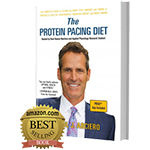My first introduction to a road warrior (RW) occurred during my childhood watching my dad, a traveling clothes salesman, prepare for the work week every Sunday. His routine involved organizing and packing huge bags of clothing samples he would carry up from the basement, one by one, and load into the trunk of his car.
It was an exhausting way to start the work week, and it didn’t stop there. Every day during the week he would go through the same routine along his “territory route”… unloading and loading each clothing sample bag at each of the department stores and private retail shops he visited.
At the time, I didn’t pay much attention to the physical demands of his job as a traveling salesman. But now, I fully appreciate and marvel at what he accomplished each week for more than 33 years!
Without question, it was his diet (ok… and bag lifting J) that kept him healthy, strong, and mentally prepared throughout his career as a true “road warrior”.
Similarly, many hard-working men and women continue to hit the pavement, train tracks or airways as ‘road warriors’ and a healthy, nourishing diet is crucial to keeping them healthy and on top of their A game when they reach their destination.
Below, is the “Road Warrior PRISETM Survival Kit” we use at PRISESM Protocol, LLC (www.priseprotocol.com) to nourish clients while traveling. It’s hard to maintain a healthy diet traveling, so these strategies provide the necessary foundation.
Road Warrior PRISETM Nourishment Survival Kit
Rule #1: Eat a 2:1 ratio of carbohydrates to protein or two carbohydrate calories for every one protein calorie. This 2:1 ratio is especially important at your “power lunches” to keep you mentally sharp and energized. Too often, poor food choices at lunch turn “power lunches” into “weakness lunches” and we feel sluggish and energy-depleted.
This 2:1 ratio of carbs to protein stabilizes blood sugar, replenishes energy stores, nourishes muscles and brain, and revs metabolism.
In practical terms, this translates to 50% of total calories as carbs, 25% protein and the remaining 25% as healthy fats and oils. The primary nutrient to keep track of is protein.
Plan to eat 0.64 – 0.82 grams of protein per pound of body weight per day. Most packaging on food contains this information.
For example:
150 lb. person should eat 96 – 123 grams of protein per day (150 X 0.64 = 96 grams; 150 X 0.82 = 123 grams)
*If you add exercise to your daily routine, add an additional 20-25 grams immediately following your exercise session. Individuals above 60 years old should aim for the higher level of protein intake (0.82 grams/pound of body weight).
An easier way to keep track of this is to eat 40 grams (or 160 calories) as carbs, 20-30 grams (or 80-120 calories) as protein, and then add in some fat (about 9 grams or 80 calories) for a total of ~320-360 calories at 4 – 6 meals per day.
Rule #2: Eat a protein- and fiber rich breakfast. Starting the day with a 20-30 gram serving of protein and 8-10 grams of fiber revs your metabolism, quenches hunger, and promotes healthy lean body mass (muscles). Other added benefits are increased mental focus and you stay ‘regular’. J
Rule #3: Pack a cooler. Stuff the cooler with water, cut veggies, fresh fruit, Greek yogurt, cottage cheese, homemade protein smoothies, natural peanut butter with rice cakes, homemade hummus, trail mix, hard-boiled eggs, protein bars and your favorite stuffed pita or sandwich wraps. If nothing else, it keeps hunger pangs in check and drastically reduces the likelihood of binging on fast-food.
If you plan to be driving all day, re-stock the cooler at a grocery store along the way. This also provides an opportunity to get out of the car, stretch, walk around and pick food you want, instead of sitting at a restaurant or worse yet, a fast-food drive-up window and order only what is available on the menu. I highly recommend grocery store pit stops en route to your destination.
It’s more difficult to re-stock at a grocery store when traveling by train, so plan ahead and pack some extra protein bars. Your goal is to feel nourished, energized and thinking clearly when you arrive at your destination.
Rule #4: Eat every 3 hours, even if it’s only a protein-rich snack. At PRISESM Protocol LLC (www.priseprotocol.com) we recommend traveling with a protein bar (providing ~20 grams of protein) or protein powder (20-30 grams) to mix with water whenever hunger strikes.
Air travel is the most time-efficient method and allows us to arrive at our destination the quickest, but it’s also the trickiest environment to maintain a healthy eating plan. Restrictions on size of carry-ons make bringing food a challenge. This is unfortunate because air travel food (airports and planes) often suffers in taste and quality.
Regardless, packing food for air travel is the same… higher-protein, nutrient-dense and convenience. Excellent choices are protein bars and powders, homemade trail mix. During flight, choose fresh veggies and fruit, yogurt, and trail mix and always opt for water or tea to drink.
Follow these strategies as a Road Warrior and you will feel great and be on top of your game!

